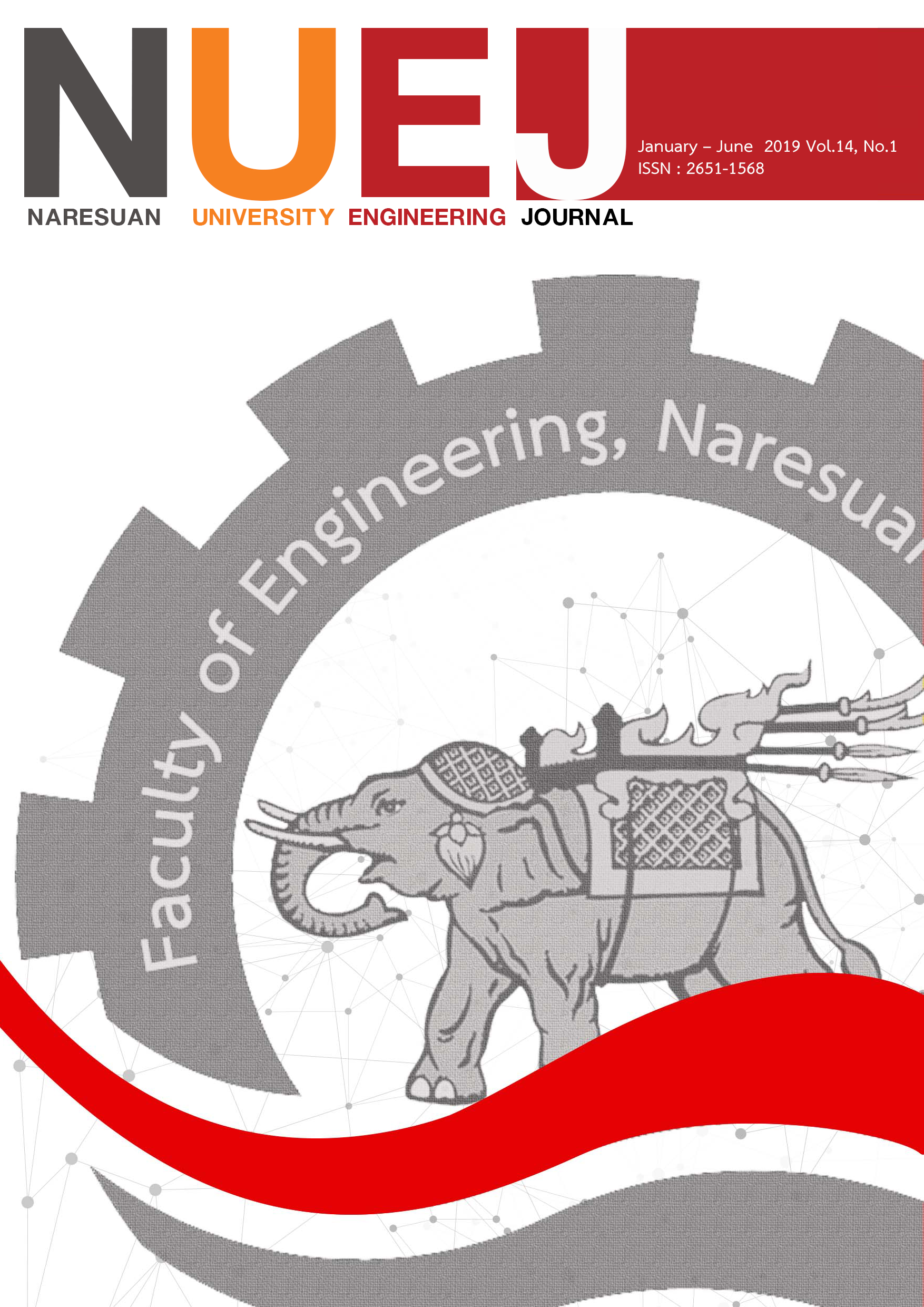เครื่องให้ความร้อนเหนี่ยวนำแบบสองหัวโดยใช้วงจรอินเวอร์เตอร์แบบกึ่งบริดจ์ที่ถูกดัดแปลง
Main Article Content
บทคัดย่อ
บทความนี้นำเสนอวงจรอินเวอร์เตอร์แบบกึ่งบริดจ์ที่ถูกดัดแปลงสำหรับประยุกต์ใช้เป็นเครื่องให้ความร้อนเหนี่ยวนำแบบสองหัว โดยใช้หลักการเรโซแนนซ์แบบอนุกรมในการควบคุมกำลังไฟฟ้าด้านออกของวงจร นอกจากนี้สวิตช์หลักในวงจรยังทำงานได้ภายใต้เงื่อนไขแรงดันศูนย์ (Zero-voltage switching : ZVS) ซึ่งทำให้ไม่เกิดกำลังไฟฟ้าสูญเสียในช่วงของการเริ่มนำกระแสของสวิตช์ วงจร ที่ได้ทำการนำเสนอได้ถูกออกแบบ สร้างและทดสอบการทำงานที่พิกัดกำลังไฟฟ้ารวม 1,300 วัตต์ (หัวละ 650 วัตต์) แรงดันไฟฟ้าขาเข้ากระแสสลับ 230 โวลต์ 50 เฮิรตซ์ และความถี่สวิตช์ 40-50 กิโลเฮิรตซ์ โดยได้ทำการทดสอบให้ความร้อนแบบเหนี่ยวนำกับชิ้นงานโลหะขนาดเส้นผ่านศูนย์กลาง 12, 9 และ 6 มิลลิเมตร โดยพบว่าประสิทธิภาพสูงสุดของวงจรอินเวอร์เตอร์มีค่าเท่ากับ 98.67 %
Article Details
How to Cite
Meesrisuk, W., Sanajit, N., & Jangwanitlert, A. (2019). เครื่องให้ความร้อนเหนี่ยวนำแบบสองหัวโดยใช้วงจรอินเวอร์เตอร์แบบกึ่งบริดจ์ที่ถูกดัดแปลง. วิศวกรรมสาร มหาวิทยาลัยนเรศวร, 14(1), 41–49. สืบค้น จาก https://ph01.tci-thaijo.org/index.php/nuej/article/view/133709
บท
Research Paper
References
[1] Carretero, C., Lucía, Ó., Acero, J., Burdío, J.M. (2015). Phase- shift modulation in double half-bridge inverter with common resonant capacitor for induction heating appliances. IET Power Electron., 8(7), 1128–1136.
[2] Lucía, Ó., Burdio, J. M., Millan, I., Acero, J., Puyal, D. (2009). Load-adaptive control algorithm of half-bridge series resonant inverter for domestic induction heating. IEEE Trans. Ind. Electron., 56(8) , 3106-3116.
[3] Sarnago, H., Lucía, Ó., Mediano, A., Burdío, J.M. (2015). Analytical model of the half-bridge series resonant inverter for improved power conversion efficiency and performance. IEEE Trans. Power Electron., 30(8), 4128 – 4143.
[4] Viriya, P., Yongyuth, N., Matsuse, K. (2008). Analysis of two continuous control regions of conventional phase shift and transition phase shift for induction heating inverter under ZVS and NON-ZVS operation. IEEE Trans. Power Electron., 23(6), 2794-2805.
[5] Yungtaek, J., Jovanovic, M. M. (2007). A new PWM ZVS full-bridge converter. IEEE Trans. Power Electron., 22(3), 987-994.
[6] Burdio, J. M., Barragan, L. A., Monterde, F., Navarro, D., Acero, J. (2004). Asymmetrical voltage-cancellation control for full-bridge series resonant inverters. IEEE Trans. Power Electron., 19(2), 461-469.
[7] Devara, V.B., Neti, V., Maity, T., Shunmugam, P. (2016) : .Capacitor-sharing two-output series-resonant inverter for induction cooking application. IET Power Electron., 9(11), 2240–2248.
[8] Kongsakorn, P., Jangwinitlert, A. (2010). A two-output high frequency series resonant induction heater’. Proc. Int. Conf. Electrical Engineering/Electronics Computer Telecommunications and Information Technology (ECTI-CON), 842–845.
[9] Burdío, J. M., Monterde, F., García, J. R., Barragán, L. A., Martínez, A. (2005). A two-output series-resonant inverter for induction-heating cooking appliances. IEEE Trans. Power Electron., 20(4), 815-822.
[10] Ogiwara, H., Itoi, M., Nakaoka, M. (2004) .PWM-controlled soft-switching SEPP high-frequency inverter for induction-heating applications. IEE Proc., Electr. Power Appl., 151(4), 404–413.
[11] Kamidaki, C. and Guan, N., (2014) .On AC resistance of two-layered wires. Proc. Int. Conf. Antennas and Propagation (ISAP), 161–162.
[2] Lucía, Ó., Burdio, J. M., Millan, I., Acero, J., Puyal, D. (2009). Load-adaptive control algorithm of half-bridge series resonant inverter for domestic induction heating. IEEE Trans. Ind. Electron., 56(8) , 3106-3116.
[3] Sarnago, H., Lucía, Ó., Mediano, A., Burdío, J.M. (2015). Analytical model of the half-bridge series resonant inverter for improved power conversion efficiency and performance. IEEE Trans. Power Electron., 30(8), 4128 – 4143.
[4] Viriya, P., Yongyuth, N., Matsuse, K. (2008). Analysis of two continuous control regions of conventional phase shift and transition phase shift for induction heating inverter under ZVS and NON-ZVS operation. IEEE Trans. Power Electron., 23(6), 2794-2805.
[5] Yungtaek, J., Jovanovic, M. M. (2007). A new PWM ZVS full-bridge converter. IEEE Trans. Power Electron., 22(3), 987-994.
[6] Burdio, J. M., Barragan, L. A., Monterde, F., Navarro, D., Acero, J. (2004). Asymmetrical voltage-cancellation control for full-bridge series resonant inverters. IEEE Trans. Power Electron., 19(2), 461-469.
[7] Devara, V.B., Neti, V., Maity, T., Shunmugam, P. (2016) : .Capacitor-sharing two-output series-resonant inverter for induction cooking application. IET Power Electron., 9(11), 2240–2248.
[8] Kongsakorn, P., Jangwinitlert, A. (2010). A two-output high frequency series resonant induction heater’. Proc. Int. Conf. Electrical Engineering/Electronics Computer Telecommunications and Information Technology (ECTI-CON), 842–845.
[9] Burdío, J. M., Monterde, F., García, J. R., Barragán, L. A., Martínez, A. (2005). A two-output series-resonant inverter for induction-heating cooking appliances. IEEE Trans. Power Electron., 20(4), 815-822.
[10] Ogiwara, H., Itoi, M., Nakaoka, M. (2004) .PWM-controlled soft-switching SEPP high-frequency inverter for induction-heating applications. IEE Proc., Electr. Power Appl., 151(4), 404–413.
[11] Kamidaki, C. and Guan, N., (2014) .On AC resistance of two-layered wires. Proc. Int. Conf. Antennas and Propagation (ISAP), 161–162.

